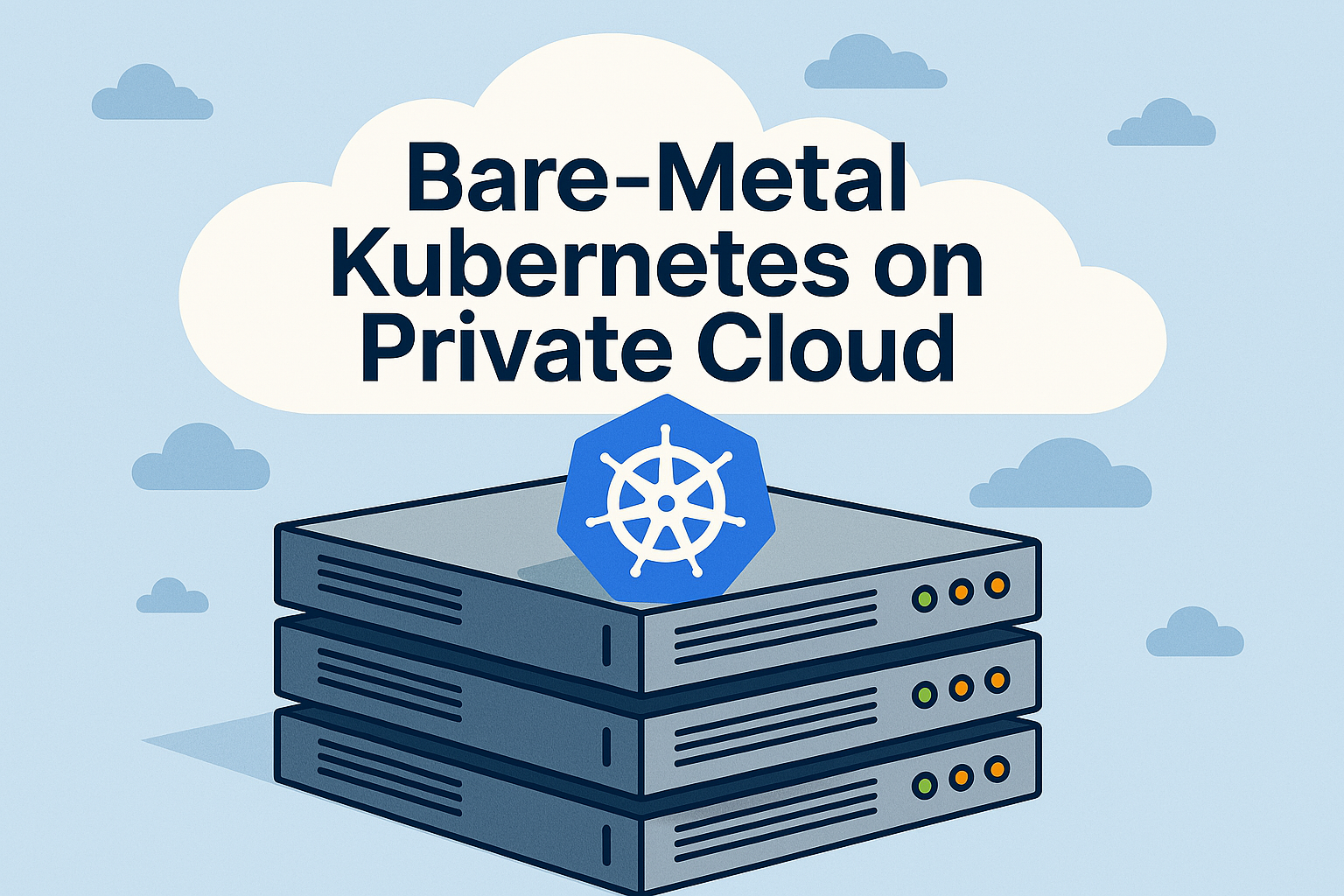How to run Kubernetes on bare-metal with cloud-like agility

Kubernetes is at home when in the cloud.
Public cloud (aka the cloud) has a very high degree of elasticity. You can commission cloud resources instantly on-demand and decommission the instant you stop consuming.
The public cloud providers abstract away most of the operational heavy lifting in compute, network, and storage hardware. IaC tools like OpenTofu and Pulumi utilize these abastractions and enable you to automate the entire lifecycle of Kubernetes clusters in the cloud.
It makes running Kubernetes a breeze.
Bare-metal Kubernetes in a private cloud is totally different.
What Is Bare-Metal Kubernetes?
Bare-metal Kubernetes refers to running Kubernetes clusters directly on physical servers in a private cloud or a data center environment.
In a private cloud, there are no elastic provisioning features like in the public cloud. Not even a virtualization layer to abstract away the hardware.
This model grants you full control over hardware and networking—but also strips away the convenience of cloud-native automation and scalability.
The result? Operational friction. Tasks that take minutes in a public cloud can stretch into hours—or worse—in bare-metal setups unless you proactively invest in tooling and automation. This is why the public cloud has become the platform of choice for Kubernetes.
But there are cases like latency and security that demand your Kubernetes clusters to live on-premises—in your private cloud.
How would you exploit the full potential of Kubernetes and avoid operational friction in such cases?
Here are three best practices that you can follow:
#1: Automate Cluster Provisioning with custom workflows
In the public cloud, spinning up a cluster is practically a one-touch operation with IaC tools like OpenTofu or AWS CDK
On bare-metal? Infrastructure as Code (IaC) hits roadblocks: hardware doesn’t scale elastically, provisioning isn’t API-first, and each new cluster feels like bespoke engineering.
To overcome this challenge you must blend IaC tools with ecosystem-specific automation and build custom workflows. These solutions are not available out-of-the box. You need to work them out according to your requirements.
Here are three popular options.
Kubernetes Cluster API with the Metal³: This is—a relatively new but—promising tool set for managing Kubernetes clusters on bare-metal.
The Kubernetes cluster API is a sub-project within Kubernetes. It implements a set of declarative APIs and controllers to automate Kubernetes cluster operations like provisioning, upgrading, and scaling.
Metal³ (pronounced “metal cubed”) is an open-source project that brings bare-metal infrastructure management into the Kubernetes ecosystem. It’s designed for situations where you want to run Kubernetes clusters directly on physical servers—no cloud, no virtualization.Rancher: Rancher is a well-known tool for managing Kubernetes clusters on bare-metal and on the cloud. It streamlines cluster provisioning, upgrades, and role-based access across environments.
Kubespray: Kubespray is an open-source project that helps you deploy production-ready Kubernetes clusters using Ansible playbooks. It’s especially handy if you want more control over your cluster setup without diving into every low-level detail.
There are pros and cons in each of these options. Once you select a tool set, migrating to another will be a lot of work. So know their limitations and choose.
But do not settle for manually provisioning your Kubernetes cluster.
The more you automate, the less time you’ll spend firefighting—or babysitting bootstrap scripts.
#2: Gain Unprecedented Visibility
Cloud-native environments offer dashboards, alerts, and auto-integrated observability. Bare-metal Kubernetes doesn’t come pre-gift-wrapped with any of this.
Without deliberate effort, you’ll lack insights into system health, resource bottlenecks, and user behavior—complicating everything from debugging to scaling decisions.
So you must build your visibility stack.
You'll appreciate that unlike Kubernetes cluster provisioning tools we discussed above, visibility tools are more abundant, more polished, and more sophisticated. There are many options you can choose from.
But, don't bring more tools than you need. Your visibility too stack only needs tools for metrics, logs, and traces.
- Metrics: Metrics are time-series numbers. They don't demand massive storage so collect all possible metrics on your Kubernetes clusters. Prometheus is the industry standard for metrics in the cloud-native world.
- Logs: Logs are textual data of important events in your Kubernetes cluster. Being textual, logs demand high storage capacity. For retention and aggregation of logs, go with a tool like Grafana Loki. It indexes metadata efficiently, reducing storage requirements without sacrificing searchability.
- Tracing: Tracing helps you track the path of a request across multiple microservices. You can use Jaeger or Grafana Tempo if you need tracing.
Visibility isn’t optional—it’s the gateway efficient incident response.
Visibility is also one of the building blocks for closed-loop automation—giving the automation workflows the feedback required to close the loop.
#3: Enable Cluster Sharing Across Teams
In the cloud, spinning up a cluster per team is easy: just provision the right number of nodes with auto-scaling enabled. On bare-metal, each cluster is tied to a fixed set of physical nodes. Over-provision, and you waste resources. Under-provision, and you block innovation.
So, embrace thoughtful cluster sharing:
- Use Namespaces, ResourceQuotas, and Network Policies to safely isolate workloads across teams.
- Apply role-based access with RBAC to keep team boundaries secure.
- Ensure observability per team to prevent noisy neighbors and track usage.
But don’t go overboard. A single “mega cluster” that serves everyone can introduce cascading failure risks. Find your sweet spot—usually a small set of shared clusters segmented by business domain, security boundary, or lifecycle stage.
Wrapping Up
Running Kubernetes on bare-metal isn’t for the faint of heart—but it’s far from impossible. The key lies in adopting cloud-inspired tooling, prioritizing automation, and designing your clusters like a shared resource, not a collection of snowflakes.
With smart tooling and a bit of sweat upfront, bare-metal Kubernetes can match the agility of its public cloud cousins—minus the multi-tenant price tag.
Curious how to design a high-availability setup on bare-metal or integrate GitOps into this picture? Let’s dig deeper in upcoming posts.

